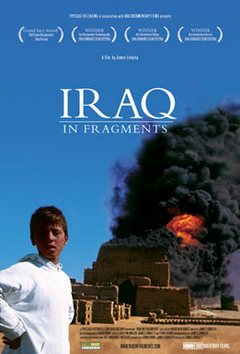 There are many films about Iraq and the situation there in the past decade. Nearly all of them focus on the American forces, whether they are for or against them. But hardly ever do we see what it is like to live under the occupying forces and the internal violence that has sprung up in the country.
There are many films about Iraq and the situation there in the past decade. Nearly all of them focus on the American forces, whether they are for or against them. But hardly ever do we see what it is like to live under the occupying forces and the internal violence that has sprung up in the country.
Iraq in Fragments presents the chaotic story from the inside, and from the point-of-view of the ordinary person who has to live there. The film was shot in 2004-6, so it is a few years out of date, but the story it tells is the same now as it was then.
The whole film is shot in a nervous verite-style and follows the lives of three people living in Iraq. Against a backdrop of bombs, smoke, debris and soldiers the people live out their lives, trying to make sense of it in one way or another.
The first segment follows 11-year old Sunni Mohammed Haithem who is working in a car repair shop to help support his family. His Father was taken away for speaking out against Saddam Hussein and has not been seen since. He is attending school part-time, but even after 5 years he is still in the 1st grade, can just about spell his own name, but to his disgrace not his Father’s.

He talks about the fear he felt when the war was raging overhead, listens to the political talk of his co-workers, and dreams of somehow being in a place that is less scary. After much conflict with his boss he eventually moves on from his old job to a new one where he hopes things will be better.
The second section is filmed amongst the Shias in the south, and it is here in the middle section that the nervous energy of the film is at its height, whether its amongst the flagellating devotees at religious ceremonies; the politico-religious meetings organising elections and rallies; following the Mehdi Army as it hunts down alcohol sellers; or at funerals of the martyrs there is a rhythm and a pace to it that is relentless.

This section is seen through the eyes of Sheik Aws al Kafaji, a 32-year old in charge of one of the Sadr offices, and it is his voice that we hear in the interviews. The atmosphere gets increasingly tense and there is a real sense of danger in the air. The film just about manages to capture the start of the 2004 Sadr uprising, but afterwards the filmmaker had to flee in fear for his life.
In the third section we really see the rifts amongst the different ethnic groups in Iraq. This part of the film is set in the North of the country amongst the Kurdish population. An old Father is trying to raise his last son, whom he would like to become an iman. The boy himself though is not doing well at school, and is working in the brickyards to help support his family, and looking after the sheep at other times.
Meanwhile chaotic elections which bring dreams of greater control over their own lives are going on. The crowds waiting to vote are getting out of control, and there are many skirmishes. Inside the attendants tell the people who to vote for, and where to put their mark.
The film early on catches the sharp divisions that have arisen in Iraqi society now that Saddam is no longer there. Although the Sunnis, Shias and Kurds all talk about unity, in fact they all feel resentment at the other group, and the fall into political chaos seems to be foreshadowed on all sides.
There is very good background information written by the director of the film on this page. You can buy the DVD here.
if the video does not appear on the page, try reloading the page; and if that doesn’t work, leave a comment so I can update the page (the comment is not published)
